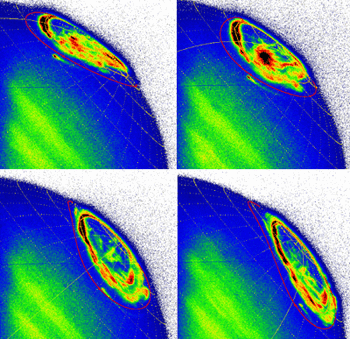Astronomers studying Jupiter's atmosphere have spotted a colossal flare erupting from the planet's aurora - a phenomenon never seen before. The intense plume at the northern polar region of the giant planet lasted just a few minutes and covered an area the size of the Earth. Hunter Waite of the University of Michigan in the US and colleagues believe that the impact of the solar wind on the magnetosphere of the giant planet could have played a crucial role in the event (J H Waite et al 2001 Nature 410 787).

Aurora on Earth arise from the interaction of the solar wind with our planet’s magnetic field. In contrast, astronomers believe that Jupiter’s aurora – the most powerful in the solar system – is driven chiefly by electromagnetic coupling of Jupiter’s ionosphere to its disk. The disk is mainly composed of volcanic matter ejected from Jupiter’s moons, but Waite’s team believes that the flare itself could have been initiated by dramatic changes in the solar wind. “The new observations suggest that Jupiter’s aurora is truly multi-faceted”, Waite told PhysicsWeb.
The flare erupted in September 1999 on the dusk side of Jupiter and reached its peak intensity 70 seconds later, increasing in brightness by a factor of 30. It then faded and disappeared in a similar time. “We were very surprised to see the flare”, says Waite. “The rapid increase in intensity over such a large area was quite unexpected and is hard to explain”. The observations were made in the ultraviolet, visible and infrared portions of the spectrum using the imaging spectrograph on board the Hubble Space Telescope.
The strength of the solar wind at Jupiter was unknown at the time of the outburst, prompting Waite and colleagues to make an estimate based on the pressure of the solar wind on the Earth’s atmosphere at that time. Their calculations showed that a series of pressure pulses had buffeted Jupiter’s upper atmosphere in the days preceding the event. Variations in the pressure of the solar wind are known to cause similar – but less spectacular – effects in Earth’s aurora. This led Waite’s team to speculate that similar processes may be at work in Jupiter’s aurora.
The Galileo spacecraft – which was travelling through Jupiter’s magnetosphere at the time of the flare – reported nothing unusual, suggesting that these enormous flares may be quite common. The Pioneer missions of the 1970s revealed that Jupiter’s magnetosphere is highly sensitive to fluctuations in the solar wind, and other studies have also linked solar wind with auroral features.
Astronomers are eagerly awaiting analysis of images taken during the Cassini fly-by of Jupiter last December, which coincided with solar wind observations by the Hubble Space Telescope and Galileo. According to Waite, “the preliminary results are very exciting and promise a new understanding of Jupiter’s aurora”.



